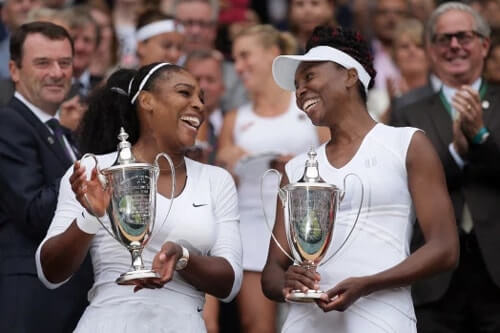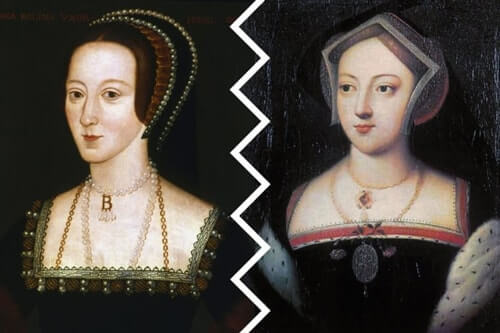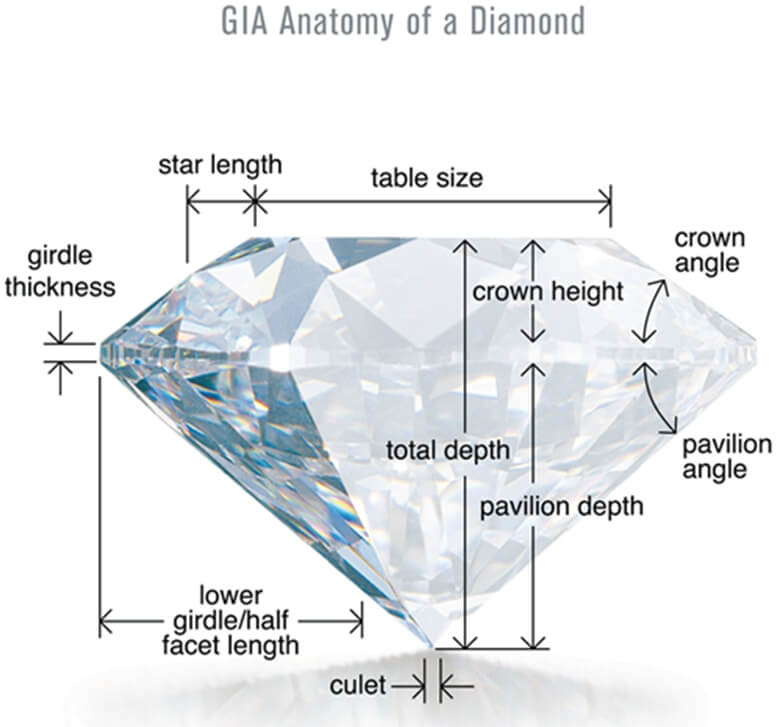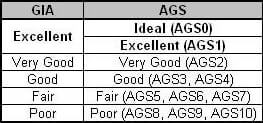Ideal or Excellent Cut Diamonds? Cut Above the Rest
Let’s be honest - popping the question is the easy part! Now you need to dig in and learn all about what makes a diamond sparkle. No matter what color and clarity you go, one thing's for sure - you want to get a diamond with the top quality cut in your budget.
In the first of our series of articles on diamond cut grades, we will be tackling one of the most important and widely asked questions: what the is the difference between an Ideal cut diamond and an Excellent cut diamond?
In the simplest terms, a diamond graded as ‘ideal cut’ will be from AGS diamond grading laboratory, while a diamond graded as ‘excellent cut’ will be graded from the GIA diamond grading laboratory. These are the two most respected grading labs in the USA, and like to many titans of industry, they have an interesting history.
A House Divided:
Almost everyone who knows anything about evaluating (or even simply buying) diamonds has heard of the GIA (the Gemological Institute of America). It is the most well-known diamond grading lab in the world, and is the benchmark upon which all diamonds are evaluated. A smaller subset of these peeps will also know that the GIA was set up in the 1950’s by a young whipper snapper named Robert Shipley.
Rob was sick and tired of the lack of standardization when it came to grading (and therefore pricing) diamonds.
Dealers and retailers in the industry would simply make up ways to rank diamonds, often using different lettering such as ‘A/AA/AAA’, or words like ‘super/super plus/super plus-plus’ as a way to identify the quality of different diamonds.
Trying to Understand Diamond Ranking
In order to overcome this utter madness, good old Rob only went ahead and set up a diamond school where retailers, traders and the like could go and train how to evaluate diamonds using the standards he had created (the 4 C’s ). Around the same time, he also set up a laboratory so these lazy retailers and traders didn’t even have to learn how to grade diamonds themselves, they could simply send them in and have them done by a professional gemologist! Fine for some, eh?
Anywho, if that wasn’t enough, at the same time our boy Robert set up a professional society of Jewelers called the American Gem Society, where jewelers (and I’m just spit balling here) could just kinda sit around talking about how awesome they were. And just in case you didn’t spot it, the ‘American Gem Society’ is…. Yup, you’ve got it… the AGS!

YAS! Robert Shipley created BOTH sister organizations; the GIA and the AGS! In a way, one might argue that he was kinda like tennis coach/father legend Richard Williams - creating two titans of their field, destined to go head-to-head eventually….

Things plodded along nicely for a few decades, the GIA doing their thing and the AGS doing theirs. That was until a dude named Peter Yantzer (head of the GIA labs in the 1990s) came along and turned things from the Williams Sisters into the Bolyen Sisters:

Mary Had an Affair with the Anne's Husband. Then Anne Was Beheaded. Awkward.
Peter was a trail blazer, and like most trail blazers he wanted to be a disrupter. He suggested to the GIA Board of Directors that they should be a little more transparent with the more intricate details of the measurements of each diamond they grade, so as to offer customers more information on the stone they were planning to buy (such as the crown angle, crown height, pavilion angle, and pavilion depth measurements). Needless to say, the Board lost their sh*t and told him very politely to take a long walk off a short pier (this may not have happened, but this is my dramatization and I’ll do as I please). You see, many of the powers that be in the diamond biz at the time (diamond cutters, diamond traders etc.), reeeally didn’t want customers to know too much. An informed customer is a wary customer, after all. Who wants a customer who understands light performance/diamond quality (and therefore knows your diamond is a dud)? Not these guys!
So, Peter’s plan to introduce extra details to the diamond grading reports at the GIA backfired, and Peter decided to take his cutting-edge idea elsewhere… to the GIA’s sister company, the AGS! They welcomed him with open arms, only too delighted to finally have a reason to steal some customers off the GIA. Were you a customer yearning to know how the weight of your potential forever stone was distributed between the upper and lower halves of the diamond? The AGS was the place for you! The AGS officially started a diamond grading lab in 1996 (headed by none other than trail blazer Peter Yantzer) … and the rest they say, is history.
A Cut Above the Rest?
Now that we know the GIA and the AGS are basically warring siblings (but not really, I’m being dramatic), we can now take look at their different approaches to diamond cut grading. But first, a reminder of the science behind cut. Yes, you have to know this, so stop moaning.

What makes a well-cut diamond? And what makes a poor cut diamond? A well-cut diamond is one with just the right diamond cut proportions to make use of the three key light performance properties needed to get that blingy look we all crave;
- How the light from the outside world bounces off the different facet of the stone (i.e. ‘ light reflection’)
- How the light from the outside world bends as it enters the stone (known as ‘refraction’)
- How the light from the outside world scatters around inside the stone (called ‘dispersion’)
When the light bounces, bends and scatters in juuuust the right way, we get what is known in the ‘biz’ as brilliance, fire and scintillation! The way the diamond is cut therefore, is absolutely crucial to getting the most brilliance/fire/scintillation out of the diamond, right? They better the cut, the more opportunity the light has to do its thing, and this is all down to how all the angles of the diamond relate to each other! Confused? Let’s look at these three examples to remind ourselves:

The first is an example of an excellent/ideal cut diamond (i.e. perfect proportions). It’s not too shallow and not too deep. The light enters from the top, bounces around inside like a kid in a bouncy castle, then flies back out from the top of the stone straight into our faces. Result?
BRILLIANCE/FIRE/SCINTILLATION UP THE WAZOO. The second is an example of a diamond that’s cut far too deep, resulting in light leakage (light leaking out the bottom of the stone). Indeed, a poorly cut diamond can leak faster than a White House Aide to the New York Times. This will leave us with a dull, flat looking diamond. We’ll call this particular example, ‘The Kellyanne’. The third is just as offensive – the light manages to bounce around inside alright, but then jumps off to the side of the diamond rather than back up through the top where we need it to be in order for us to see it. We might call this one ‘The Steve’. Now, let’s remind ourselves of the anatomy of the diamond before we really dive into the weeds here:

Cool, Cool.
Now, how does the AGS grade a diamond’s cut? Well first the analyse the diamond based on three distinct factors:
- The Light Performance: here they assess the brightness of the stone (the light return of white light), the contrast (light parts Vs dark parts), the amount of light leakage (we saw this above with ‘The Kellyanne’), and finally ‘dispersion’ (how the light scatters around inside).
- The Diamond’s Proportions: Here they measure things such as the tilt (the point at which the girdle reflects in the table of a diamond, don’t worry about it), the weight ratio (how the carat weight is distributed between the top and bottom halves of the stone), the thickness of the girdle, and also the culet.
- The Finish: How well is the diamond polished? Is it symmetrical?
Once all three of these factors have been measured at the lab, they use a grading scale of letters and numbers to assign a grade, just like this:

AGS Ideal (0) is the best cut grade you can get here, while AGS Poor (8-10) is just rubbish. If a stone gets an AGS Ideal grade, it means that it has excelled in all three of our factors outlined above, and it is officially a bad ass diamond that won’t take no sh*t from nobody.
Over at the GIA on the other hand, they do things a little differently when it comes to cut. The GIA has five grade levels for cut: Excellent, Very Good, Good, Fair and Poor. IN order to decide which grade to give, they analyse the diamond based on three distinct factors, just like the AGS. The GIA’s diamond cut quality factors are slightly different:
- The Face-Up Appearance: How the diamond performs when it is looked at from above (i.e. when on your finger) based on the attributes of brightness, fire and scintillation (we know these terms now!)
- The Design: How well the diamond was designed to ensure durability? What is the weight ratio of the stone?
- The Craftsmanship: The quality of the workmanship or craftsmanship that went into aligning and polishing the diamond’s facets?
Again, once all three of these factors have been measured at the lab they use a grading system to assign a grade from the hierarchy below:

An excellent cut grade from GIA means that that particular stone excelled in all three categories, and is also, a bad ass diamond. No good cut diamond please.

So what is the difference between an AGS Ideal and a GIA Excellent? Very little to be honest. Take a look at this little chart just to see how closely related they are:

As you can see, they are pretty must identical except for the fact that AGS has actually split their top tier into two categories, while GIA has both of those type of stones in one bundle, the ‘excellent’ bundle. This means of course, that an AGS ‘excellent’ is actually a lower cut quality than a GIA ‘excellent’. On the flip side however, an AGS ‘ideal’ could be a better cut quality diamond than some of the GIA ‘excellent’ stones. Confusing, right? Uh, I’m bored. Dog break? Yes.

Fancy Pupper Do the Reads
OK, you’ve had your fun. Back to diamonds.
Both labs are comparable in how they analyze polish and symmetry. So, if a diamond was graded the highest grade by the AGS for polish and symmetry (‘ideal’), it would also be given the highest grade from the GIA (‘excellent’). It’s in the way that they measure proportions that the GIA falls a little short to be honest here folks. See, while the AGS gives EXACT measurements for the crown, pavilion, lower girdle facet length, and the star facet length, the GIA actually rounds those measurements to the nearest half a percent/half a degree. I don’t know why they do this, but I imagine this little wiggle room might explain those few ‘excellent’ cut GIAs that would not quite make it into the ‘ideal’ AGS category.

The Bottom Line:
You’re confused. You’re tired. Your cranky. You just want me to shut the F up and tell you whether you should buy an AGS ideal or a GIA excellent, amiriiiight? Toughen up buttercup! As with everything, there are pros and cons. Both labs have strengths. For instance, also the AGS does have a slight edge over the GIA when it comes to proportions (due to the GIA doing the whole rounding up thing), they are not as strict with their clarity grade bands (i.e. how many imperfections are in the diamond). GIA are a little better at that. The GIA also has the added bonus of being better known amongst customers (and therefore can command a higher price). So in short, it’s really not a question of one being better than the other, but rather what matters to you. Besides, as an industry insider once told me, a retailer who sells GIA diamonds will swear they are the best, while a retailer who sells AGS will tell you the opposite!
The truth is, no matter what diamond laboratory you stone is graded with (GIA or AGS), you should always aim to purchase within these parameters (for round brilliant cut diamonds):
- Table : 54% - 60%
- Depth : 59% - 63%
- Crown Angle : 33° - 35°

